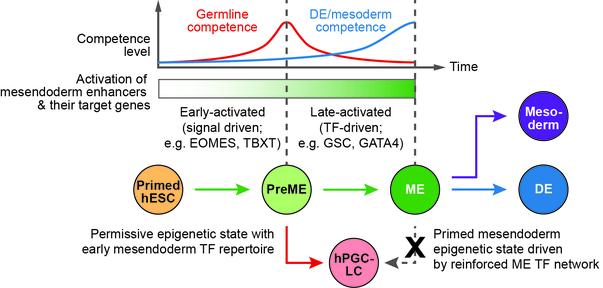
Submitted by Mel Quy on Tue, 12/04/2022 - 09:46
New paper published by the Surani Lab
Abstract
Germline–soma segregation is a fundamental event during mammalian embryonic development. Here we establish the epigenetic principles of human primordial germ cell (hPGC) development using in vivo hPGCs and stem cell models recapitulating gastrulation. We show that morphogen-induced remodelling of mesendoderm enhancers transiently confers the competence for hPGC fate, but further activation favours mesoderm and endoderm fates. Consistently, reducing the expression of the mesendodermal transcription factor OTX2 promotes the PGC fate. In hPGCs, SOX17 and TFAP2C initiate activation of enhancers to establish a core germline programme, including the transcriptional repressor PRDM1 and pluripotency factors POU5F1 and NANOG. We demonstrate that SOX17 enhancers are the critical components in the regulatory circuitry of germline competence. Furthermore, activation of upstream cis-regulatory elements by an optimized CRISPR activation system is sufficient for hPGC specification. We reveal an enhancer-linked germline transcription factor network that provides the basis for the evolutionary divergence of mammalian germlines.
Walfred W. C. Tang, Aracely Castillo-Venzor, Wolfram H. Gruhn,Toshihiro Kobayashi, Christopher A. Penfold, Michael D. Morgan, Dawei Sun, Naoko Irie and M. Azim Surani
Read the full paper here https://www.nature.com/articles/s41556-022-00878-z

